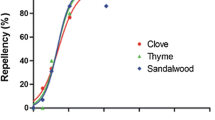Abstract
Repellency and toxicity of 8 essential oils (vetiver grass, cassia leaf, clove bud, cedarwood, Eucalyptus globules, Eucalyptus citrodora, lemongrass and geranium) were evaluated against the Formosan subterranean termite, Coptotermes formosanus Shiraki. Vetiver oil proved the most effective repellent because of its long-lasting activity. Clove bud was the most toxic, killing 100% of termites in 2 days at 50 μg/cm2. The tunneling response of termites to vetiver oil also was examined. Vetiver oil decreased termite tunneling activity at concentrations as low as 5 μg/g sand. Tunneling and paper consumption were not observed when vetiver oil concentrations were higher than 25 μg/g sand. Bioactivity of the 8 oils against termites and chemical volatility were inversely associated. Listed in decreasing order of volatility, the major constituents of the 8 oils were: eucalyptol, citronellal, citral, citronellol, cinnamaldehyde, eugenol, thujopsene, and both α- and β- vetivone. Vetiver oil is a promising novel termiticide with reduced environmental impact for use against subterranean termites.
Similar content being viewed by others
REFERENCES
ANONYMOUS. 1998. SAS user's guide: Statistics. SAS Institute, Cary, NC.
ADAMS, R. P. 1991. Cedar wood oil-analysis and properties. Mod. Meth. of Plant Anal. 12:159–173.
AHMAD, F. B. H., MACKEEN, M. M., ALI, A. M., MASHIRUN, S. R., and YAACOB, M. M. 1995. Repellency of essential oils against the domiciliary cockroach, Periplaneta americana. Insect Sci. Applic. 16:391–393.
BULTMAN, J. D., BEAL, R. H., and AMPONG, F. F. K. 1979. Natural resistance of some tropical African woods to Coptotermes formosanus Shiraki. For. Prod. J. 29:46–51.
CARTER, F. L., GARLO, A. M., and STANELY, J. B. 1978. Termiticidal components of wood extracts: 7-methyljuglone from Diospyros virginiana. J. Agri. Food Chem. 26:869–873.
CORNELIUS, M., GRACE, J. K., and YATES III, J. R. 1997. Toxicity of monoterpenoids and other natural products to the Formosan subterranean termite. J. Econ. Entomol. 90:320–325.
ERDTMAN, H., and HIROSE, Y. 1962. The chemistry of the natural order Cupressales: 46. The structure of nootkatone. Acta Chem. Scand. 16:1311–1314.
FRANZIOS, G., MIROTSON, M., HATZIAPOSTOLOU, E., KRAL, J., SCOURAS, Z. G., and MAVRAGANITSIPIDOU, P. 1997. Insecticidal and genotoxic activities of mint essential oils. J. Agric Food Chem. 45:2690–2694.
GRACE, J. K., AND YAMAMOTO, R. T. 1994. Natural resistance of Alaska-Cedar, redwood, and teak to Formosan subterranean termites. Forest Prod. J. 44:41–45.
IKEDA, T., TAKAHASHI, M., NISHIMOTO, K. 1978. Antitermitic components of Kaya wood, Torreya nucifera Sieb. Et Zucc. Mokuzai Gakkaishi. 24:262–266.
JAIN, S. C., NOWICKI, S., EISNER, T., and MEINNALD, J. 1982. Insect repellents from vetiver oil: 1. Zizanal and epizizanal. Tetra. Let. 23:4639–4642.
LEWIS, D. L., MICHAELS, G. E., HAYS, D. B., CAMPBELL, W., and SMITH, V. 1978. Evaluation of the antitermitic activity of hydroxyquinoline and naphthol derivative formulations using Reticulitermes in laboratory and field experiments. J. Econ. Entomol. 71:818–821.
LIN, T.-S., and YIN, H.-W. 1995a. Effects of Litsea cubeba pres oils on the control of termite Coptotermes formosanus Shiraki. Taiwan For. Res. Inst. New Series 10:59–63.
LIN, T.-S., and YIN, H.-W. 1995b. The effects of Cinnamomum spp. oils on the control of the termite Coptotermes formosanus Shiraki. Taiwan For. Res. Inst. New Series 10:459–464.
LWANDE, W., NDAKALA, A. L., HASSANALI, L., MOREKA, E., NDUNGU, M., AMIANI, H., GIYU, P. M., MALONZA, M. M., and PUNYUA, D. K. 1999. Gynandropsis gynadra essential oil and its constituents as tick (Rhipicephalus appendiculatus) repellents. Phytochemistry 50:401–405.
NAGNAN, P., and CLEMENT, J. L. 1990. Terpenes from the maritime pine Pinus pinaster: toxins for subterranean termites of the genus Reticulitermes (Isoptera: Rhinotermitidae). Biochem. Syst. Ecol. 18:13–16.
NGOH, S. P., CHOO, L. E., PANG, F. Y., HUANG, Y., KINI, M. R., and HO, S. H. 1998. Insecticidal and repellent properties of nine volatile constituents of essential oils against the American cockroach, Periplaneta americana (L.). Pestic Sci. 54:261–268.
PERRUCCI, S. 1995. Acaricidal activity of some essential oils and their constituents against Tyrophagus longior, a mite of stored food. J. Food Prod. 58:560–563.
SAEKI, I., SUMIMOTO, M., and KONDO, T. 1973. The termiticidal substances from the wood Chamaecyparis pisifera D. Don. Holzforschung. 27:93–96.
SCHEFFRAHN, R. H., HSU, K. C., SU, N. Y., HUFFMAN, J. B., MIDLAND, S. L., and SIMS, J. J. 1988. Allelochemical resistance of bald cypress, Taxodium distichum, heartwood to the subterranean termite, Coptotermes formosanus. J. Chem. Ecol. 14:765–776.
SHAAYA, E., RAVID, U., PASTER, N., JUVEN, B., ZISMAN, U., and PISSAREV, V. 1991. Fumigant toxicity of essential oils against four major stored-product insects. J. Chem. Ecol. 17:499–504.
SHARMA, R. N., TUNGIKAR, V. B., PAWAR, P. V., and VARTAK, P. H. 1994. Vapour toxicity and repellency of some oils and terpenoids to the termite, Odontotermes brunneus. Insect Sci. Applic. 15:495–498.
SINGH, D., and SINGH,-A. K. 1991. Repellent and insecticidal properties of essential oils against housefly, Musca domestica L. Insect. Sci. Applic. 12:487–491.
ST. PFAU, A., and PLATTNER, P. 1939. Etudes sur les matieres vegetales volatiles X. Sur les vetivones, constituents odorants des essences de vetiver. Helv. Chim. Acta 22:640
WATANABE, A. K., SHONO, Y., KAKIMIZU, A., MATSUO, N., SATON, A., and NISHIMURA, H. 1993. New mosquito repellent from Eucalyptus camaldulensis. J. Agric. Food Chem. 41:2164–2166.
ZHU, B. C. R., HENDERSON, G., CHEN, F., MAISTRELLO, L., and LAINE, R. A. (2001). Nootkatone is a repellent for Formosan subterranean termite (Coptotermes formosanus). J. Chem. Ecol. 27:523–531.
Author information
Authors and Affiliations
Rights and permissions
About this article
Cite this article
Zhu, B.C.R., Henderson, G., Chen, F. et al. Evaluation of Vetiver Oil and Seven Insect-Active Essential Oils Against the Formosan Subterranean Termite. J Chem Ecol 27, 1617–1625 (2001). https://doi.org/10.1023/A:1010410325174
Issue Date:
DOI: https://doi.org/10.1023/A:1010410325174




